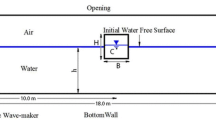Abstract
A Constrained Interpolation Profile (CIP)-based model is developed to predict the mooring force of a two-dimensional floating oil storage tank under wave conditions, which is validated against to a newly performed experiment. In the experiment, a box-shaped floating oil storage apparatus is used. Computations are performed by an improved CIP-based Cartesian grid model, in which the THINC/SW scheme (THINC: tangent of hyperbola for interface capturing; SW: Slope Weighting), is used for interface capturing. A multiphase flow solver is adopted to treat the water-air-body interactions. The Immersed Boundary Method (IBM) is implemented to treat the body surface. Main attention is paid to the sum force of mooring line and velocity field around the body. It is found that the sum force of the mooring line increases with increasing wave amplitude. The body suffers from water wave impact and large body motions occur near the free surface. The vortex occurs near the sharp edge, i.e., the sharp bottom corners of the floating oil storage tank and the vortex shedding can be captured by the present numerical model. The present model could be further improved by including turbulence model which is currently under development. Comparison between the computational mooring forces and the measured mooring forces is presented with a reasonable agreement. The developed numerical model can predict the mooring line forces very well.
Similar content being viewed by others
References
Greco, M., Colicchio, G., and Faltinsen, O. M., 2009. Bottom slamming for a very large floating structure: Coupled global and slamming analyses. Journal of Fluids and Structures, 25(2): 420–430.
Hirt, C. W., and Nichols, B. D., 1981. Volume of Fluid (VOF) method for the dynamics of free boundaries. Journal of Computational Physics, 39(1): 201–225.
Hong, D. C., Hong, S. Y., and Hong, S. W., 2004. Numerical study of the motions and drift force of a floating OWC device. Ocean Engineering, 31(2): 139–164.
Hu, C. H., and Kashiwagi, M., 2004. A CIP-based method for numerical simulations of violent free surface flows. Journal of Marine Science and Technology, 9(4): 143–157.
Hu, C. H., and Kashiwagi, M., 2009. Two-dimensional numerical simulation and experiment on strongly nonlinear wave-body interactions. Journal of Marine Science and Technology, 14(2): 200–213.
Koo, B. J., and Kim, M. H., 2005. Hydrodynamic interactions and relative motions of two floating platforms with mooring lines in side-by-side offloading operation. Applied Ocean Research, 27(6): 292–310.
Ma, Q. W., and Yan, S., 2009. QALE-FEM for numerical modeling of non-linear interaction between 3D moored floating bodies and steep waves. International Journal for Numerical Methods in Engineering, 78(6): 713–75.
Peskin, C. S., 1972. Flow patterns around heart valves: A numerical study. Journal of Computational Physics, 10(2): 252–271.
Takewaki, A., Nishiguchi, A., and Yabe, T., 1985. Cubic interpolated Pseudo-particle method (CIP) for solving hyperbolic-type equations. Journal of Computational Physics, 61(2): 261–268.
Vandamme, J., Zou, Q., and Reeve, D., 2011. Modeling floating object entry and exit using Smoothed Particle Hydrodynamics. Journal of Waterway, Port, Coastal, and Ocean Engineering, 137(5): 213–224.
Xiao, F., Honma, Y., and Kono, T., 2005. A simple algebraic interface capturing scheme using hyperbolic tangent function. International Journal for Numerical Methods in Fluids, 48(9): 1023–1040.
Xiao, F., Satoshi, I., and Chen, C. G., 2011. Revisit to the THINC scheme: A simple algebraic VOF algorithm. Journal of Computational Physics, 230(19): 7089–7092.
Yabe, T., and Wang, P. Y., 1991. Unified numerical procedure for compressible and incompressible fluid. Journal of the Physical Society of Japan, 60(7): 2105–2108.
Yabe, T., Xiao, F., and Utsumi, T., 2001. The constrained interpolation profile method for multiphase analysis. Journal of Computational Physics, 169(2): 556–593.
Yokoi, K., 2007. Efficient implementation of THINC scheme: A simple and practical smoothed VOF algorithm. Journal of Computational Physics, 226(2): 1985–2002.
Zalesak, S. T., 1979. Fully multi-dimensional flux-corrected transport algorithm for fluid flow. Journal of Computational physics, 31(3): 335–362.
Zhao, X. Z., 2011. Validation of a CIP-based tank for numerical simulation of free surface flows. Acta Mechanica Sinica, 27(6): 877–890.
Zhao, X. Z., and Hu, C. H., 2012. Numerical and experimental study on a 2-D floating body under extreme wave conditions. Applied Ocean Research, 35(1): 1–13.
Zhao, X. Z., Hu, C. H., and Sun, Z. C., 2010. Numerical simulation of focused wave generation using CIP method. In: The Proceedings of the Twentieth International Offshore and Polar Engineering Conference. Beijing, 596–603.
Author information
Authors and Affiliations
Corresponding authors
Rights and permissions
About this article
Cite this article
Chu, X., Dong, S. & Zhao, X. Prediction of the mooring force of a 2-D floating oil storage tank. J. Ocean Univ. China 13, 901–910 (2014). https://doi.org/10.1007/s11802-014-2332-z
Received:
Revised:
Accepted:
Published:
Issue Date:
DOI: https://doi.org/10.1007/s11802-014-2332-z




